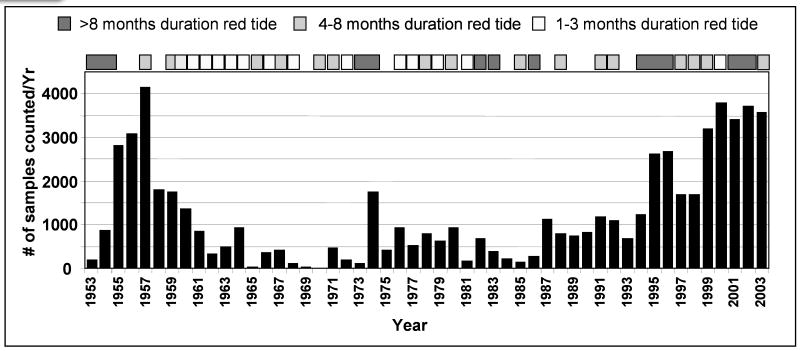Background
Harmful Algal Blooms (HABs) occur throughout the world with Florida having the distinction of being home to all major toxin-producing marine, estuarine and freshwater microalgae. The subtropical warm climate, 1200 miles of coastline, varied aquatic habitats and the human interface through seafood consumption and from water activities compose an environment where the presence of aquatic toxins can have a significant impact on public health. In Florida, the estimated annual economic impacts from HABs are in the magnitude of millions of dollars with direct effects to both tourism and public health. Nationwide, approximately $22 million is attributable to public health issues related to seafood ingestion alone (Anderson et al., 2000). Additional costs yet to be determined relate to respiratory illness, lost wages due to illness and increased burden on the health care.
During the past two decades there has been a dramatic increase in the population along Florida's coastline; 80% of the population lives near the coast and greater numbers either vacation or participate in recreational activities at the shore. Coincident with this increase in population, has been an apparent increase in frequency and distribution of toxic blooms. In the waters off Florida, blooms of the microscopic, toxic dinoflagellate Karenia brevis (known as the environmental phenomenon ‘red tide’, though not specific to K. brevis) have occurred in the Gulf of Mexico 25 out of 26 years since records have been kept (Figure 1).
Figure 1.
Historical red tide sampling effort and yearly red tide duration in Florida. All data was derived from the FWRI Florida Historical Red Tide database. Note that number of samples counted per year for red tide is the total number of counts made, regardless of the presence or absence of K. brevis in the sample (Haverkamp et al, 2004).
The geographic extent of the blooms appears to have increased in recent years with some blooms extending from the SW coast of Florida all the way to Texas. Blooms can cover over 10,000 square miles (Heil and Reich, 2005). Blooms of red tide are increasingly implicated in the deaths of marine mammals, birds and fish and the effects on human health are actively being documented in multi-institutional studies based in Florida (Fleming et al., 2007). The increased reliance of the state on tourism for its economic health together with an increasing population at risk for exposure to HABs, makes the assessment of health-related illness from aquatic toxins an important and emerging public health issue.
Historically, Neurotoxic Shellfish Poisoning (NSP) has been the illness associated with Florida red tide toxin (brevetoxin) exposures. Recently, exposures through inhaling airborne toxins have been described (for review, see Kirkpatrick, B. et al., 2004). K. brevis toxins are released into the water and with wind and wave action are incorporated into the sea spray (marine aerosols). Several Florida-based studies have identified human respiratory response from exposure to brevetoxin aerosols. People exposed to the toxins in a recreational beach setting reported upper and lower airway symptoms (Backer et al., 2003). Additional studies reported symptoms ranging from predominantly upper airway symptoms (such as eye and throat irritation) in healthy lifeguards to both upper and lower airway symptoms (eye and throat irritation, cough, shortness of breath and wheezing) in asthmatics (Backer et al., 2005; Fleming et al., 2005; Fleming et al., 2007). In these studies, air flow parameters measured by spirometry in the healthy subjects revealed no significant changes. However, statistically significant decreases in airflow parameters were measured in asthmatic subjects after a 1-hour exposure to airborne brevetoxins while on the beach. In a companion study, asthmatics were asked to record symptoms and peak flow for 10 days after the beach walk exposure. Subjects reported increased symptoms (such as cough, chest tightness, nasal congestion and eye irritation) for five days after the beach exposure (Kirkpatrick et al., 2007).
A retrospective study examining emergency room admissions at a coastal hospital found coastal residents had a 54% increase in admissions for respiratory diagnosis during an onshore red tide compared to when there was no red tide (Kirkpatrick et al., 2006) based on zip code of residency. With these recent findings, there is an increased demand for coastal residents and transient populations (such as “snow birds” and tourists) to know when there are high toxin conditions to minimize their exposure to these toxic aerosols.
There are only a few institutions in Florida that perform routine monitoring activities for K. brevis blooms. These include Florida Fish and Wildlife Conservation Commission, Mote Marine Laboratory, and the Florida Department of Agriculture and Consumer Services. These efforts are extremely important for the management of commercial shellfish beds and the protection of people who eat oysters, clams, and other mollusks. In Florida, regulations require that shellfish beds be closed when K. brevis cell counts reach or exceed 5,000 cells per liter of seawater. Cell identification and enumeration are determined using light microscopy by highly trained scientists for proper identification with results generally reported several days after sample collection. Rapid temporal and spatial variability occur with Florida red tide due to its patchy nature and its ability to be affected by wind and currents in the near shore environment (G. Kirkpatrick, personal communication). Brevetoxin analysis can be performed using High Performance Liquid Chromatography (HPLC) and Enzyme-Linked ImmunoSorbent Assay (ELISA), and reporting continues to be disconnected from current conditions by days or even weeks. A number of HAB policy assessments have reported the need for the development of real time toxin analysis (HARNESS, 2005; Ocean US, 2006). However, beach visitors do not necessarily need carefully measured and reported toxin levels. They need to know if it's okay to go to the beach and not become ill due to inhalation of red tide toxins (Kirkpatrick et al., 2008).
The NOAA HAB Bulletin (http://coastwatch.noaa.gov/hab/bulletins_ns.htm) is a valuable tool for public health managers, resource managers and environmental scientists. It shows bloom location, forecast of short-term bloom movement, and likelihood of adverse health effects due to near or onshore impacts (Figure 2). Access to the imagery is delayed one week for public access to ensure accuracy of bloom characterization.
Figure 2.
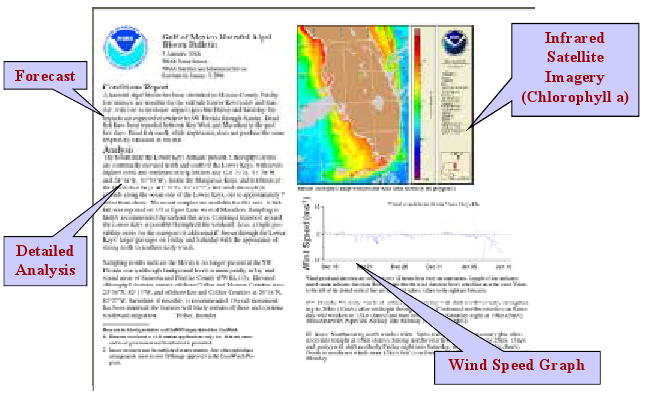
National Oceanic and Atmospheric Administration (NOAA) HAB Bulletin
Real time beach reporting can improve asthmatics' and local coastal residents' quality of life as well as tourists visiting the area. The Florida tourism promotion agency notes that 80% of people who visit the state come for the beaches (www.visitFlorida.com). The tourism industry has supported a system that provides real time beach conditions to guide visitors to areas not impacted by blooms.
With increasing evidence that these inhaled toxins can compromise the health of beachgoers, particularly on days when there are high amounts of toxins in the air, a system that provides frequent and timely reporting on beach conditions is needed. Ideally, this reporting system would consist of objective data such as the amount of brevetoxins in the air. However, there is not currently a method of toxin detection that provides rapid analysis.
This article reports on the implementation and expansion of a community- based beach conditions reporting system. (Note: Much of this article is an expansion of the pilot Beach Conditions Reporting System program which is published in Science and the Total Environment, see Kirkpatrick et al., 2008).
The Beach Conditions Reporting System
The Beach Conditions Reporting System (www.mote.org/beaches) was the creative innovation of Dr. Barbara Kirkpatrick, Program Manager of the Environmental Health Program at Mote Marine Laboratory, Sarasota, Florida. Through seed money provided by the Florida Department of Health's Aquatic Toxins Program (from a Centers for Disease Control and Prevention grant, #U50-CCU423360-01), a real-time beach conditions reporting system was initially designed and implemented in Sarasota County, Florida. The Sarasota-based system received widespread success and universal acceptance by citizens, public health community, and local governments. Additional funding from local county and city governments; the citizen group, Solutions to Avoid Red Tide (START); and the Florida Fish and Wildlife Conservation Commission (through its Red Tide Control and Mitigation Fund) have resulted in the expansion of this system to a total of nine counties in southwest Florida and the Florida Panhandle (Figure 3).
Figure 3.
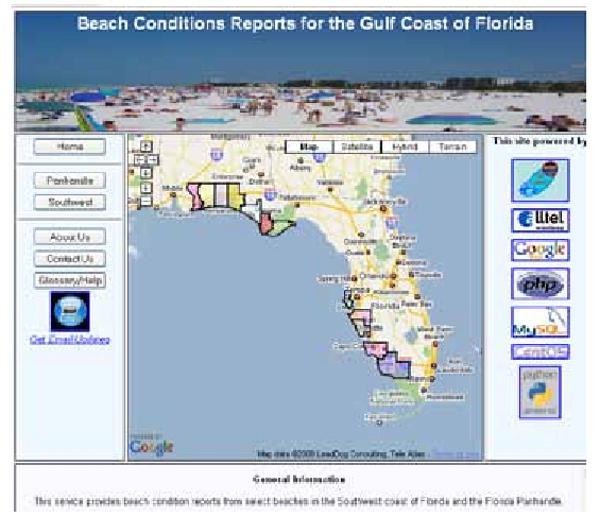
Beach Conditions Reporting System for the Gulf Coast of Florida
Originally, beaches selected for the Conditions Reporting System had year-round, 7 day-a-week, full time lifeguards making them ideal sentinels for reporting changing beach conditions. These lifeguards provide subjective reports including level of respiratory irritation and amount of dead fish on the beach. A key component in the design of the beach observing system was to create an easy reporting pathway for the lifeguards to minimize the amount of time away from their primary duties. The system provides a PDA (personal data assistant, Blackberry®) for each of the beaches. The portable, battery powered unit allows the lifeguards to take the unit to their beach guard tower and report beach conditions by inputting data to the website easily on-site.
Training was done by Mote Marine Laboratory Environmental Health biologists. Lifeguards were taught data input procedures and provided a rubric for each of the subjective reports. Step-by-step written instructions were also provided as an insert in the unit's storage case, along with a phone number for assistance. Guards provide beach conditions once they have their tower set up for the day at 10:00 am and also at midshift at 3:00 pm. Interim reports are encouraged, especially as conditions change during the day.
The data is automatically transferred via an Alltel wireless Internet connection to a website hosted on the Mote Marine Laboratory Sarasota Operations of the Coastal Ocean Observation Laboratories (SO COOL) server. A secure data entry webpage per county was developed for condition parameters to permit easy utilization and for standardizing responses; this system hallows the lifeguard/user to simply click and highlight their selection as well as for different information from different counties to be inputted.
The output is displayed on a Google Earth map. The user can select the beach of interest and a pop up window provides the most recent report for that beach with a date and time stamp (see Figure 4). To reach people who may not be connected to the Internet, an automated voice system automatically transfers the data to a telephone message (941-BEACHES).
Figure 4.
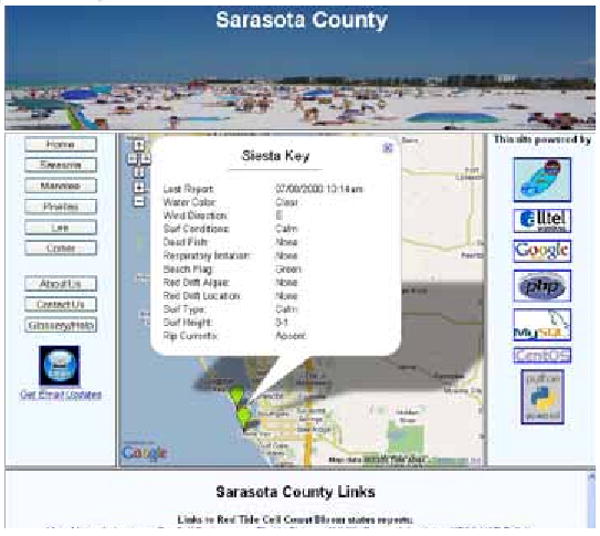
Web user view of Siesta Key beach data
The types of data that are reported are
Dead Fish: None, Few, Many
Respiratory Irritation: None, Slight, Moderate, High
Water Color: Clear, Moderate, Dark
Wind Direction: From N, S, E, W
Surf Condition: Calm, Moderate, Rough With some counties now also reporting:
Florida Beach Warning Flag flying: Green, Yellow, Red, Double Red, Purple
Surf Height: 0-1′, 1-2′, 2-3′, 3-4′, 4-5′, 5-6′, 6′ and over
Surf Type: Calm, Light Chop, Ground Swell, Wind Chop, Heavy Surf
Presence or Absence of Rip Currents
Presence and Placement of Red Drift Macroalgae or Seaweed
As the Beach Conditions Reporting expanded, so have the types of sentinels and the types of data communication that were used. In counties with no full-time, year-round lifeguards, the system has successfully used park rangers at county and state parks, as well as beach patrol officers. Where wireless Internet connections were not available and/or funding was minimal, a desktop computer using the same secure data entry as the PDA was used, with the sentinels calling the information in from the beach to the office personal on location (i.e. park ranger office, toll booth, or another location's desktop user). In areas without public beach access and/or no full time sentinels, proprietary locations have been tried (hotel and condo managers), but was unsuccessful for many reasons.
Examples of the effectiveness of the system are shown in the next two figures. In Figure 5, Venice beach reported high respiratory irritation. In Figure 6, Siesta Key filed a report within two minutes of the Venice report with no respiratory irritation. If users checked the site prior to leaving for the beach, they could redirect to Siesta Key Beach and minimize any effects from airborne toxins.
Figure 5.
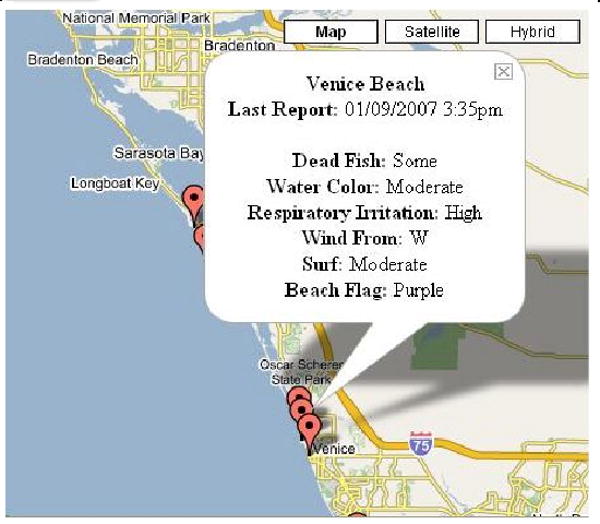
Venice Beach Report
Figure 6.
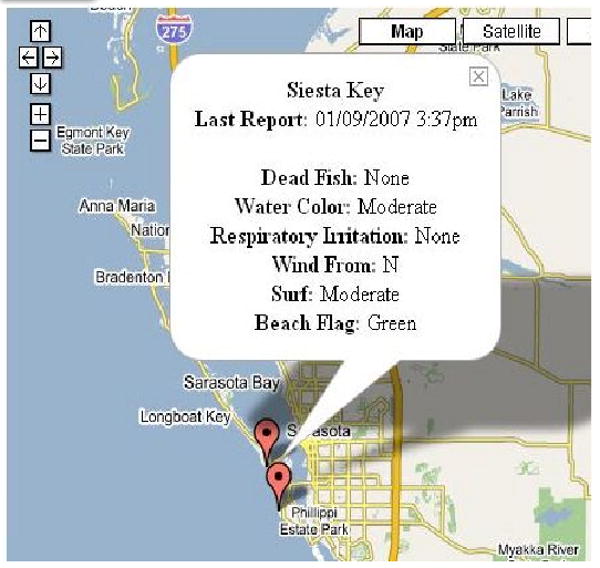
Siesta Key Beach Report
The website also provides links to sources of Florida red tide information, plus other beach impacting events such as UV index and weather data, links to County Health Departments and County and State Parks and Recreation Divisions, DOH's Healthy Beaches website (http://esetappsdoh.doh.state.fl.us/irm00beachwater/default.aspx), as well as links to tourism websites that may give users other recreational activities for days not optimal for a good beach experience.
The Beach Conditions Reporting System allows recreational users to select their beach site using near real time data. Based on estimates of number of recreational users, over 70,000 people in a six month red tide could be protected from exposure and potential illness from red tide aerosols. The beach reporting system also gives both residents and visitors the ability to make the best of their day at the beach, which will have a long-term effect of encouraging repeat visitation as a result of a positive experience.
In Collier County, the sentinels are park rangers for county beach sites and City of Naples Beach Patrol officers at city facilities. Collaboration across governmental agencies is one of the powerful mechanisms public health scientists and their partners can use to protect citizens and visitors from environmental agents. Additional collaborations included a group of community leaders for site selection. Synergistic and complementary activities also occur at many sites which include water sampling and testing for K. brevis red tide cell counts. Subjective data (beach reports) is corroborated with objective data (cell counts) which provides key information to improve forecast abilities to evaluate the public health impact potential and are included in the NOAA HAB Bulletin. With the addition of information on surf conditions, wave height and presence or absence of rip currents provided by the counties with lifeguards trained to measure these parameters, the National Weather Service (NWS) is also improving the forecasting abilities for warning the public of potentially deadly rip currents. The goal of both the NOAA HAB Bulletin and the NWS Rip Current forecasts are to accurately predict beach conditions out to 48 - 72 hours, allowing people to make informed decisions on weekend activities and planned events such as outdoor beach weddings or birthday parties. It also gives the public health community adequate time to prepare for potential impacts and to inform the public of imminent adverse conditions.
In the six month period following the fifth county (Collier County) addition to the Beach Conditions Reporting System, the 22 reported beaches on the website had been clicked on over 17,000 times, with more than 150 phone calls made to the automated phone number, and with only one week of active red tide blooms hitting any of the beaches.
Conclusions
During the past three decades, Florida has developed and implemented a comprehensive and successful response strategy related to K. brevis blooms and other HABs. This process includes governmental agencies (federal, state and local entities), universities, private non-profit institutions, and citizen environmental organizations. This highly collaborative team has developed a multi-pronged approach to education and outreach:
Development of local health departments HAB response plans through a bottom-up approach to ensure local buy-in and suitability by use of the HAB technical guide and implementation manual;
Training curricula for technical staff (including health care providers such as physicians, nurses, toxicologists) on appropriate HAB recognition, diagnosis and treatment including distance learning presentation, DVD development, and web-based training tools (http://www.med.miami.edu/poisoncontrol/x57.xml);
Toll-free Aquatic Toxins Health Hotline (888-232-8635) staffed at the Florida Poison Information Center in Miami providing a 24 hour, 7 days a week, 365 days per year for use by the public and for health professionals to assist in the diagnosis and management of patients with a special emphasis on red tide;
The Beach Conditions Reporting System is the premier citizen outreach tool available that informs citizens about beach red tide events and other potential hazardous beach events so that they can make informed decisions on recreational options and family health risks.
Acknowledgments
Funding for the Beach Conditions Reporting System has been provided through the Center for Disease Control and Prevention and the Florida Department of Health (Cooperative Agreement U50/CCU423360-2) as well as the PO1 ES 10594 of the National Institute of Environmental Health Sciences (NIEHS) and the Florida Fish and Wildlife Red Tide Control and Mitigation program. The authors thank the beach sentinels for their dedication to this public outreach tool.
Contributor Information
Kate Nierenberg, Mote Marine Laboratory in Sarasota.
Andrew Reich, Aquatic Toxins Program Coordinator in the Florida Department of Health's Division of Environmental Health.
Robert Currier, Mote Marine Laboratory in Sarasota.
Barbara Kirkpatrick, Mote Marine Laboratory in Sarasota.
Lorraine C. Backer, National Center for Environmental Health, Centers for Disease Control and Prevention in Atlanta, Georgia
Richard Stumpf, NOAA National Ocean Service, in Silver Spring, MD.
Lora Fleming, NSF NIEHS Oceans and Human Health Center, University of Miami, in Miami, FL.
Gary Kirkpatrick, Mote Marine Laboratory in Sarasota.
References
- Anderson DM, Hoagland P, Kaoru Y, White AW. WHOI-2000-11. Woods Hole, Mass.; Department of Biology, Woods Hole Oceanographic Institution: 2000. Estimated annual economic impacts from harmful algal blooms (HABs) in the United States. [Google Scholar]
- Backer LC, Fleming LE, Rowan A, Cheng YS, Benson J, Pierce R, Zaias J, Bean J, Bossart G, Baden DG. Recreational Exposure to Aerosolized Brevetoxins During Florida Red Tide Events. Harmful Algae. 2003;2:19–28. [Google Scholar]
- Backer LC, Kirkpatrick B, Fleming LE, Cheng YS, Pierce R, Bean JA, Clark R, Johnson D, Wanner A, Tamer R, Baden D. Occupational Exposure to Aerosolized Brevetoxins during Florida Red Tide Events: Impacts on a Healthy Worker Population. Environmental Health Perspectives. 2005;113(5):644–649. doi: 10.1289/ehp.7502. [DOI] [PMC free article] [PubMed] [Google Scholar]
- Fleming LE, Kirkpatrick B, Backer LC, et al. Initial Evaluation of the Effects of Aerosolized Florida Red Tide Toxins (Brevetoxins) in Persons with Asthma. Environmental Health Perspectives. 2005;113(5):650–657. doi: 10.1289/ehp.7500. [DOI] [PMC free article] [PubMed] [Google Scholar]
- Fleming LE, Kirkpatrick B, Backer LC, Bean JA, Wanner A, Reich A, Dalpra D, Zaias J, Cheng YS, Pierce R, Naar J, Abraham WM, Baden DG. Aerosolized Red-Tide Toxins (Brevetoxins) and Asthma. Chest. 2007;131(1):187–194. doi: 10.1378/chest.06-1830. [DOI] [PMC free article] [PubMed] [Google Scholar]
- HARNESS. Harmful Algal Research and Response: A National Environmental Science Strategy 2005 – 2015. In: Rasmdell JS, Anderson DM, Glibert PM, editors. Ecological Society of America. Washington, DC: 2005. p. 96. [Google Scholar]
- Haverkamp D, Steidinger KA, Heil CA. HAB Monitoring and Databases: The Karenia brevis example. In: Hall S, Etherrdge S, Anderson D, Kleindinst J, Zhu M, Zou Y, editors. Harmful Algae Management and Mitigation. Asia-Pacific Economic Cooperation; Singapore: 2004. APEC Publication #204-MR-04.2. [Google Scholar]
- Heil C, Reich A. Recreational Water & Harmful Algal Blooms in Florida. Conference on Promoting Public Health Through Safe Water; January 19-20, 2005; Orlando, Florida. 2005. [Google Scholar]
- Kirkpatrick B, Fleming L, Squicciarini D et al. Literature Review of Florida Red Tide: implications for human health. Harmful Algae Vol. 2004;3(2):99–115. doi: 10.1016/j.hal.2003.08.005. [DOI] [PMC free article] [PubMed] [Google Scholar]
- Kirkpatrick B, Fleming LE, Backer LC, Bean JA, Tamer R, Kirkpatrick G, Kane T, Wanner A, Reich D, Dalpra A, Baden DG. Environmental exposures to Florida Red Tides: Effects on Emergency Room Respiratory Diagnoses Admissions. Harmful Algae. 2006;(5):526–533. doi: 10.1016/j.hal.2005.09.004. [DOI] [PMC free article] [PubMed] [Google Scholar]
- Kirkpatrick B, Bean J, Fleming LE, Backer LC, Akers R, Wanner A, Dalpra D, Nierenberg K, Reich A, Baden D. Aerosolized Red Tide Toxins (Brevetoxins) and Asthma: A 10 day follow up after 1 hour acute beach exposure. In: Moestrup, editor. Proceedings of the 12th International Conference on Harmful Algae; International Society for Harmful Algae and Intergovernmental Oceanographic Commission of UNESCO; 2007. in press. [Google Scholar]
- Kirkpatrick B, Currier R, Nierenberg K, Reich A, Backer LC, Stumpf R, Fleming L, Kirkpatrick G. Florida red tide and human health: A pilot beach conditions reporting system to minimize human exposure, Science and the Total Environment (2008) 2008 doi: 10.1016/j.scitotenv. 2008.03.032. [DOI] [PMC free article] [PubMed] [Google Scholar]
- Kirkpatrick G. Personal Communication. Mote Marine Laboratory; Sarasota, Florida: 2008. [Google Scholar]
- Ocean. US. Public Health Risks: Coastal Observations for Decision-Making. Publication No 15, Arlington, VA: 2006. p. 40. [Google Scholar]



